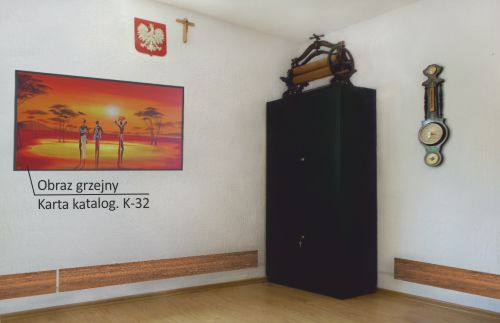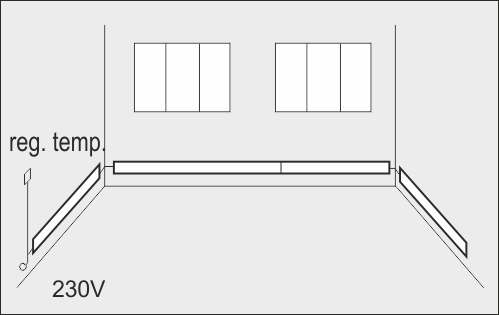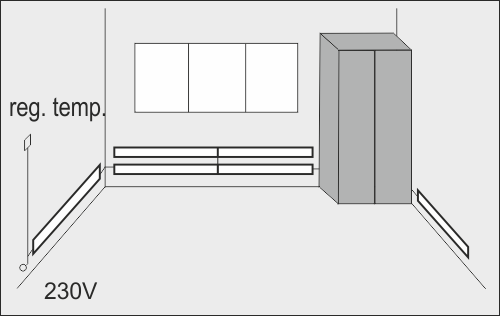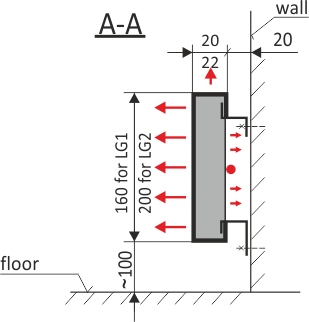OFERTA
| Listones radiantes |

Heating strips are a modular system for low-temperature heating through infra-red panel radiators. IZOTERMA heating strips are used as the main source of heating as well as complementary heating of the following spaces: residential, office, shop, warehouse, social, technical, production spaces, kiosks, cafés, hotels, schools, garages; it can be also used in non-stationary facilities such as caravans or as technology heating in technical and industrial applications.
ADVANTAGES:
- modular heating system (different lengths)
- ensures even temperature distribution in rooms
- modern and efficient; low capacity at large heating surface
- the ability of combination into any heating sets (configurations)
- heating strips can operate in horizontal or vertical position
- a power cord can be led out of every heating strip
- protects against moisture and freezing on the walls; dries damp walls
- does not require changes in existing electrical wiring, 230V
- plane heating element
- no effect of burning dust and no dust trails on the walls (dirt)
- safe to use, CE B marked
- durable, reliable

Color: RAL 7035 (light gray)


Series of produced strips type LG1
|
230V |
Output W |
Dimensions (mm) |
Weight kg |
||
| thick. |
width |
lenght |
|||
| LG1 - 450 |
60 | 20 |
160 |
450 | 0,8 |
| LG1 - 500 |
65 | 20 |
160 |
500 | 0,9 |
| LG1 - 1000 |
140 | 20 |
160 |
1000 | 1,6 |

 |
Additional materials for installation of strips - additional payment:
|
DESIGN
Closed, rectangular cross-section, made of galvanized and lacquered sheet (color - light gray: RAL7035). Heating strip releases the heat perpendicularly to its surface through radiation as well as through convection in a small portion. The strip releases the heat energy only in one direction.
INSTALLATION
on the wall, at a height of about 10 cm from the floor, around the walls of the room, in one or two rows - horizontally or vertically, in various lengths, so as it is possible to adjust to the occupation and length of the wall. Strips are fixed to the wall with the use of handles: to a wooden wall - using screws and to a brick wall - using nail expansion anchors. Electric power cable OMY 3 x 1,5mm2 L= 0.7 linear meters is introduced from the back of the strip. Parallel connection of electric cables (according to colors) with the use of connectors, maximum power of a line of strips connected to 230 V socket is 2 kW.
Installation operations:
- At a height of 230 mm from the floor make a laying-out line, with the use of a level, up to the length of a line of strips (see: A-A cross-section).
- Fix the upper handles (Z profile) to the wall using screws or anchors (see: view on a line of strips).
- Insert the lower handle to the strip - C profile.
- Place, press and insert the strip to the fixed upper handles - Z profile.
- Mark the holes for the lower handles on the wall.
- Remove the lower handles, drill holes, insert handles under the hole and tighten them using screws or anchors.
- Perform parallel electrical connection between strips in a line with the use of 3-pin connectors 2.5mm2
- Lead the power cable from the strip and insert it to the junction box. The above operations should be performed by a qualified electrician.
Lead the following out from the junction box:
- Power supply cable to 230V socket
- Power supply cable to the temperature controller.
SELECTION OF RADIANT HEATING STRIPS FOR THE ROOM
During selection, one should take into account the requirement, whether the strips are to fulfill the function of basic heating or only support the existing heating system. Thermal power demand per room depends on: the required temperature in a room, thermal insulation of walls and external temperature. Approximately, the below listed types of building structures and their heating power demand can be adopted, assuming the minimum external temperature of:
- 20 W/m³ - wooden buildings, well insulated
- 25 W/m³ - brick buildings with insulation (polystyrene, mineral wool)
- 30 ÷ 35 W/m³ - brick buildings, without insulation (old buildings)
- 5 ÷ 20 W/m³ - supporting the existing heating system
EXEMPLE OF SELECTION OF RADIANT STRIPS:
a) Details: V = 30 m3 - room volume; 20 W/m3 - power demand (assumed was item 1 - wooden building, well insulated)
Calculate: P - total power demand
Solution: P = V x 20 W/m3 = 30 x 20 = 600 W
b) Divide the calculated heating power per room - 600 W by the heating power of 1 linear meter of a strip with a power of 140 W. The calculation shows that 4.28 linear meters of strip will be needed. 4.5 linear meters of strip heaters should be assumed.
c) Depending on the length of walls and their occupation, as well as configuration of installation, one should assume the length and number of strips so as the total length of strips is equal to the power of 600 W, e.g. LG1-1000 strip - 4 pcs. and LG1-500 strip - 1 pc. - in total 4.5 linear meters.
The product is compliant with the requirements of the applicable European standards, holds the Declaration of Conformity and is marked with CE, B.
Cleaning and maintenance
Clean the external structure, with the use of a soft cloth and mild detergent. This activity should be performed with the device disconnected from the supply mains.
| ZAKŁAD PRODUKCJI URZĄDZEŃ GRZEJNYCH 55-002 Łany cerca de Wrocław, Polonia calle Odrzańska 14 |
Tel.+48 71-318-58-95 Tel.+48 71-318-58-96 e-mail: izoterma@izoterma.com.pl |

